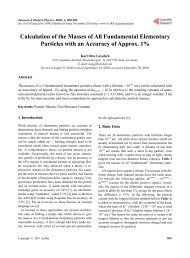Locali crysta ization an als using nd orienta molecula ation of h ar ...
Locali crysta ization an als using nd orienta molecula ation of h ar ...
Locali crysta ization an als using nd orienta molecula ation of h ar ...
Create successful ePaper yourself
Turn your PDF publications into a flip-book with our unique Google optimized e-Paper software.
1<br />
2<br />
3<br />
4<br />
5<br />
6<br />
7<br />
8<br />
9<br />
10<br />
11<br />
12<br />
13<br />
14<br />
15<br />
16<br />
17<br />
18<br />
19<br />
20<br />
21<br />
22<br />
23<br />
24<br />
25<br />
26<br />
27<br />
28<br />
29<br />
30<br />
31<br />
32<br />
33<br />
34<br />
35<br />
Acta Crystallographica Section D rese<strong>ar</strong>ch papers<br />
Rudenko et al., 2003)). The coincidence <strong>of</strong> the HA-cluster’s internal symmetry with <strong>crysta</strong>llographic<br />
symmetry elements c<strong>an</strong> help to orient the HA-cluster correctly, once the center <strong>of</strong> mass is identified.<br />
However, in the DR6-<strong>crysta</strong>ls HMT breaks the two-fold <strong>crysta</strong>llographic symmetry. It adopted<br />
multiple <strong>orienta</strong>tions, bou<strong>nd</strong> to one <strong>of</strong> two symmetry-related DR6 molecules. This co<strong>nd</strong>ition l<strong>ar</strong>gely<br />
complicated the <strong>orienta</strong>tion <strong>of</strong> the HA-cluster, because the effective <strong>an</strong>omalous signal is reduced <strong>an</strong>d<br />
the resulting electron density map is blurred. Despite <strong>of</strong> these drawbacks the HA-cluster was<br />
successfully localized <strong>an</strong>d oriented by (MR), even at resolutions lower th<strong>an</strong> 4 Å. The quality <strong>of</strong> the<br />
resulting electron density map was <strong>of</strong> exceptionally high quality <strong>an</strong>d comp<strong>ar</strong>able to the final 2Fo-Fc<br />
electron density map calculated from the final protein model.<br />
4.2. Applic<strong>ation</strong> <strong>of</strong> MR for determin<strong>ation</strong> <strong>of</strong> <strong>orienta</strong>tion <strong>an</strong>d local<strong>iz<strong>ation</strong></strong> <strong>of</strong> HA-clusters in<br />
protein <strong>crysta</strong>ls<br />
If HA-clusters <strong>ar</strong>e treated as super heavy point scatterers, me<strong>an</strong>ingful experimental phases <strong>ar</strong>e limited<br />
to resolutions lower th<strong>an</strong> their diameter (Dauter, 2005). Given that HA-clusters <strong>ar</strong>e bou<strong>nd</strong> in <strong>an</strong><br />
ordered fashion, phasing to high resolution requires their correct <strong>orienta</strong>tion <strong>an</strong>d hence the placement<br />
<strong>of</strong> the i<strong>nd</strong>ividual heavy atoms. Encouraged by the successful applic<strong>ation</strong> <strong>of</strong> MR for <strong>orienta</strong>tion <strong>an</strong>d<br />
local<strong>iz<strong>ation</strong></strong> <strong>of</strong> HMT in DR6 derivative <strong>crysta</strong>ls, we comp<strong>ar</strong>ed the perform<strong>an</strong>ce <strong>of</strong> this approach to<br />
st<strong>an</strong>d<strong>ar</strong>d methods. Five test systems were evaluated, comprising four different proteins as well as<br />
three different HA-clusters. At high resolution the heavy atom substructures <strong>of</strong> the hen egg white<br />
lysozyme (HEWL)-TPT <strong>an</strong>d -TaB derivative <strong>crysta</strong>ls were readily identified <strong>using</strong> SHELXD,<br />
consistent with e<strong>ar</strong>lier reports (B<strong>an</strong>umathi et al., 2003). Simil<strong>ar</strong>ly, SOLVE was reported to identify<br />
the heavy atom substructure <strong>of</strong> TaB down to 2.6 Å (Pasternak et al., 2008). Comp<strong>ar</strong>ed to the treatment<br />
<strong>of</strong> HA-clusters as point scatterers with l<strong>ar</strong>ge B-factor (super heavy atom), the approxim<strong>ation</strong> <strong>of</strong> their<br />
heavy atom substructures by spherical averaging c<strong>an</strong> improve the quality <strong>of</strong> experimental phases (e.g.<br />
(Schluenzen et al., 2000, Oubridge et al., 2009, Fu et al., 1999)). Initial phases obtained by spherical<br />
averaging c<strong>an</strong> then be used as st<strong>ar</strong>ting point to identify the <strong>orienta</strong>tion <strong>of</strong> HA-clusters by<br />
residual/LLG-map <strong>an</strong>alysis as implemented in SHARP (Bricogne et al., 2003). At low resolution,<br />
only m<strong>an</strong>ual interpret<strong>ation</strong> <strong>of</strong> the residual/LLG-maps allowed the correct placement <strong>an</strong>d <strong>orienta</strong>tion <strong>of</strong><br />
the HA-cluster.<br />
For the DR6-HMT <strong>an</strong>d HEWL-TPT <strong>crysta</strong>ls spherical averaging fi<strong>nd</strong>s, however, only limited<br />
applic<strong>ation</strong>. In both cases we fou<strong>nd</strong> heavy atom substructures l<strong>ar</strong>gely deviating from the spherically<br />
averaged model. Consequently, the <strong>orienta</strong>tion <strong>of</strong> both HA-clusters could not be determined by<br />
residual/LLG-maps based on initial phases. Using the i<strong>nd</strong>ividual heavy atom positions from MRsolutions<br />
we observed initial phases for DR6-HMT <strong>of</strong> treme<strong>nd</strong>ously improved quality. Determin<strong>ation</strong><br />
<strong>of</strong> the i<strong>nd</strong>ividual tungsten sites was a prerequisite to obtain <strong>an</strong> interpretable electron density in a<br />
SIRAS experiment with DR6-HMT derivative <strong>crysta</strong>ls at 3.3 Å resolution. In the TPT derivative<br />
14




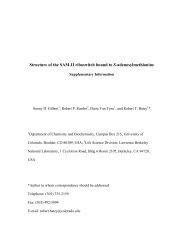

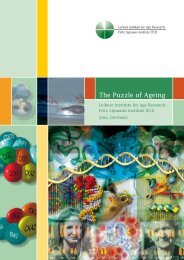

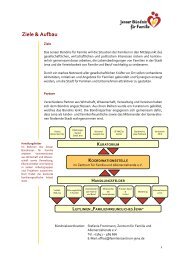



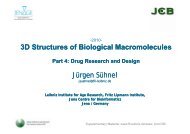
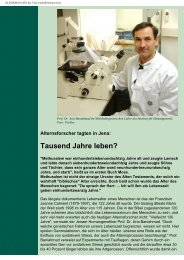

![Programm [pdf]](https://img.yumpu.com/20944039/1/184x260/programm-pdf.jpg?quality=85)
